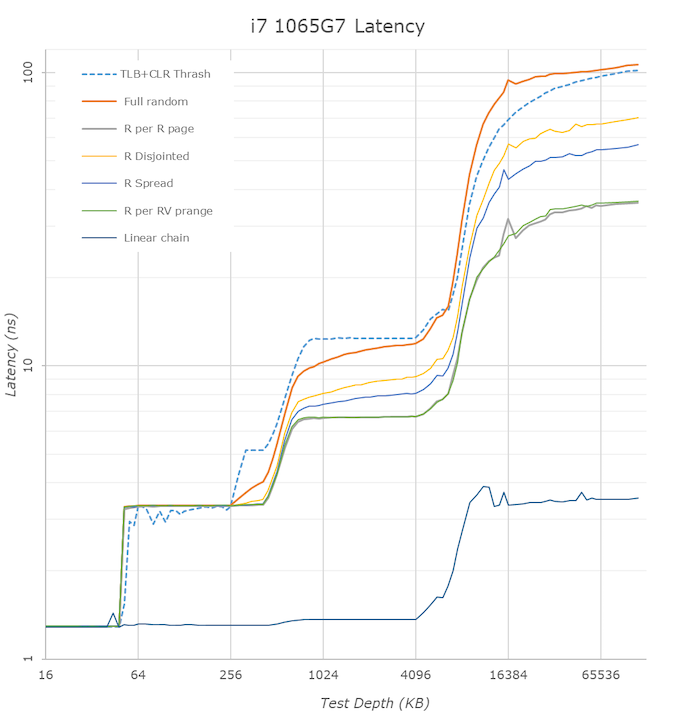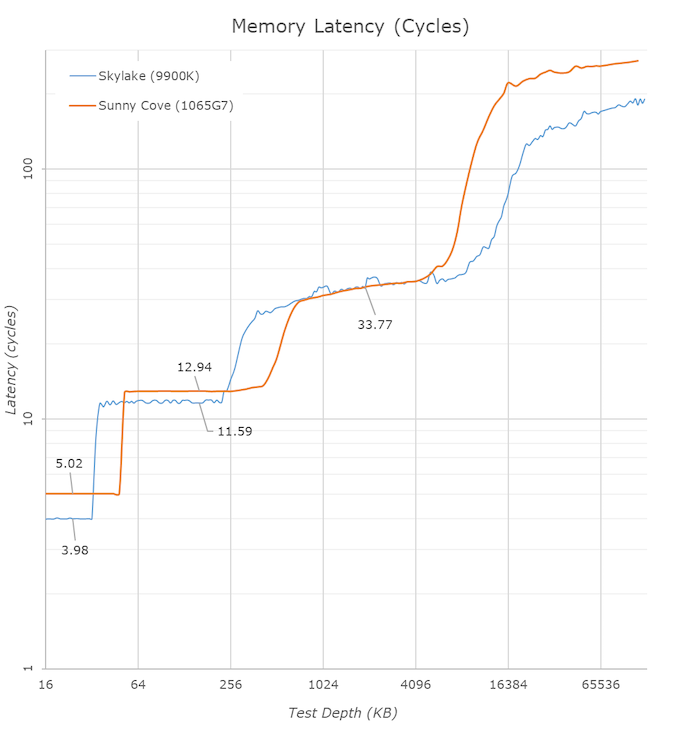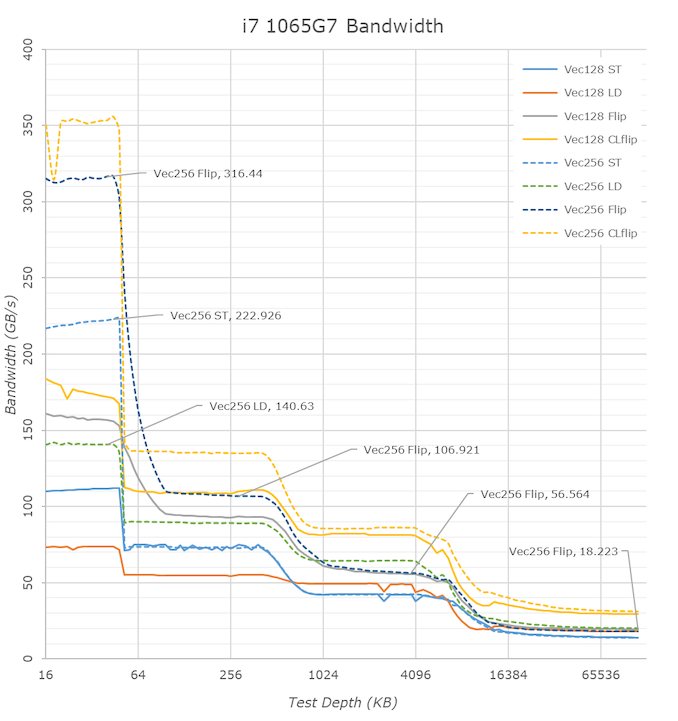The Ice Lake Benchmark Preview: Inside Intel's 10nm
by Dr. Ian Cutress on August 1, 2019 9:00 AM EST- Posted in
- CPUs
- Intel
- GPUs
- 10nm
- Core
- Ice Lake
- Cannon Lake
- Sunny Cove
- 10th Gen Core
Cache and TLB Updates
One of the biggest changes in the new Sunny Cove core is the cache hierarchy. Throughout most of the last decade, Intel has kept the same cache configuration among its server cores with very few changes, aside from improving the micro-op cache through Sandy Bridge today, but with Sunny Cove, we get some key updates.
From our microarchitecture disclosure article, we know that Sunny Cove brings with it an increased L1 data cache, as well as a doubled L2 cache, from Skylake. With this comes more associativity as well.
| Core Cache Comparison | ||||||
| Sunny Cove |
AnandTech | Cannon Lake |
Skylake | Sandy Bridge |
AMD Zen 2 |
|
| 48 KB 12-way |
L1-D | 32 KB 8-way |
32 KB 8-way |
32 KB 8-way |
32 KB 8-way |
|
| 32 KB 8-way |
L1-I | 32 KB 8-way |
32 KB 8-way |
32 KB 8-way |
32 KB 8-way |
|
| 512 KB 8-way |
L2 | 256 KB 4-way |
256 KB 4-way |
256 KB 8-way |
512 KB 8-way |
|
| 2 MB 16-way |
L3/core | 2 MB 16-way |
2 MB 16-way |
2MB 16-way |
4 MB 16-way |
|
| 2304 | uOp Cache | 1536 | 1536 | 1536 | 4096 | |
I’ve also included the size of the micro-op cache in this comparison, because we understand that the L1-I and the micro-op cache are typically located next to each other in the die design – increasing the size of one typically means limiting the size of the other, however given that both of them work to accelerate the same types of data, it is important to find the right balance: AMD for Zen 2 decided to halve the L1-I and double its associativity, and then double the micro-op cache from 2k to 4k entries. For Sunny Cove, Intel has increased the L1-D by 50%, but also increased the micro-op cache by 50%, taking advantage of the second generation 10nm process.
In the above latency graph comparison, we can notably see the new increased cache capacities. The L1’s increase from 32KB to 48KB is well visible, as well as the L2 increase from 256KB to 512KB.
On the part of the L2 it’s interesting to see that again the new core’s TLB structures don’t quite cover the whole capacity of the L2 and that’s why the latter half of the L2 has worse access latencies for L1D TLB miss patterns.
L3 latencies look similar, however we’ll dwell into that just in a bit. The DRAM latencies of course are apples and oranges in this case as Intel’s new LPPDR4X memory controller in the new ICL part doesn’t have a counter-part we can compare to, but as expected the memory latency is notably worse than a desktop part so no big surprises there.
What’s rather disappointing however is that we’re not really seeing any kind of change to the prefetchers and our access patterns between the two microarchitectures look identical. We had expected Intel to improve in this regard, but alas it seems, at least for our test cases, there’s been no improvements.
One of the major balancing acts with cache sizes is also cache latency. The bigger the cache, the longer it takes to retrieve data from it – increasing associativity can do this as well. Intel for the longest time has cited a 4-cycle latency to its L1 cache, and a 12-cycle latency to its L2 cache. This changes, in quite a substantial way.
| Core Cache Latency (in cycles) | ||||||
| Sunny Cove | AnandTech | Cannon Lake |
Skylake | Sandy Bridge |
AMD Zen 2 |
|
| 5 | L1 | 4 | 4 | 4 | 4 | |
| 13 | L2 | 12 | ~12 | 12 | 12 | |
| 30-36 | L3 | 26-37 | 34 | |||
Due to the increase in the L1 cache, that 4-cycle latency is now a 5-cycle latency. Intel is hoping that its double L1 store bandwidth will help hide that latency, however adding 20% latency onto every data fetch is a heavy hit to take. This is why a lot of the rest of the core is also beefed up, so work can still continue to cover for this extra cycle. It is worth noting that Intel’s Atom cores in the past had an L1 latency of 3 cycles, however they have also since moved to 4-cycle.
The L2 also changes, from 12 cycles to 13 cycles. You can’t double a cache for free, and it is interesting to note here that now AMD and Intel share the same L2 cache size and the same associativity, however AMD has a cycle advantage on Intel. This has a knock on effect for L3 cache latency too, which has increased from ~26-37 cycles to ~30-36 cycles on Intel, from Skylake. The latency here isn’t uniform because the cache isn’t uniform, and accessing non-local L3 slices comes with a latency penalty, as say opposed to AMD’s uniform latency L3.
One of the biggest additions Intel was keen to make in our Sunny Cove microarchitecture disclosure is the increase in the L1 bandwidth. Based on our testing, Skylake’s L1 data cache was capable of 2x32-byte read and 1x32-byte write per clock. For Sunny Cove this has increased, but it gets a bit more complicated. In one clock Sunny cove can perform 2x64-byte reads and either 1x64-byte write, or 1x32-byte write, or 2x16-byte writes. So both reads and writes, at peak, have doubled with bit width, with the write configurations being a bit more complex.
We can see the direct effects of the bandwidth change in our bandwidth tests. The L1 store bandwidth is extremely evident as it measures in at 222GB/s on the ICL part, while only reaching 139GB/s on the 28% higher clocked 9900K. If we normalise for frequency, we indeed see a doubling of the store bandwidth of the new core.
The L2 cache bandwidth looks unchanged from Skylake – the part here lags behind with an equal amount to the frequency difference. Surprisingly, the L3 bandwidth fares quite well here and is almost at parity to the desktop 9900K even though the frequency difference. The DRAM bandwidth is inferior on the ICL mobile chip, but again that’s to be expected due to the apples and oranges DRAM architecture comparison.
Moving on to the TLB configurations, and it turns out that Intel has moved where this data is stored. This data is typically stored in CPUID.02h, however it is now found in CPUID.18h, and the info between different page sizes and capabilities is now given as subdivisions. The TLBs look as follows, and broken down into configurations:
| Sunny Cove TLB | |||
| AnandTech | Type | Entries | Associativity |
| L1-D | 4K | 64 | 4-way |
| L1-D | 2M | 32 | 4-way |
| L1-D | 1G | 8 | full |
| L1-I | 4K+2M | 8 | full |
| L1-I | 4K+2M+1G | 16 | full |
| L2 | 4K+2M | 1024 | 8-way |
| L2 | 4K+1G | 1024 | 8-way |
This means that for 4K and 2M L1-I entries, there are a total 8+16 = 24 possible, but only 16 1G possible. For 4K L2 entries, there are 1024 + 1024 = 2048 entries possible, however only 1024 each of 2M/1G are possible. The peak numbers align with what Intel has told us in our microarchitecture disclosure, however it is good to dive into what is possible.













261 Comments
View All Comments
Klimax - Friday, August 2, 2019 - link
Audio/Video processing on the go. Those areas tend to get support for new extensions pretty fast. Maybe browsers. Microsoft has for a while supported AVX512 for codegen. Maybe graphics drivers might use it too. (Not sure how it is now, but Intel was pretty bad in using available instructions in their drivers.)Kevin G - Friday, August 2, 2019 - link
It is also about ISA parity. This has been on of my running issues with x86 as a whole is that the ecosystem tends to spit out a new 'major' extension every two or three years and then segment it to certain parts of the market (AVX has yet to appear on Celerons, Atoms, Pentium etc. after 8 years of being availible on Sandy Bridge). The software development side would have more incentive to optimize code for AVX is it was universally available and they didn't have to worry about a new extension on on the horizon.*I should clarify that I am referring to user space ISA extensions here. New platforms etc. will likely introduce a handful of kernel and hypervisor extensions with every iteration but those should only matter to OS and driver developers.
Phynaz - Friday, August 2, 2019 - link
Wrong wrong wrong.eva02langley - Friday, August 2, 2019 - link
Man, you two are easily the worst fanboys of all. Unable to see the big picture, only cherry picking whatever make sense to live in your delusional world of flying dinosaurs and laser sharks.Korguz - Friday, August 2, 2019 - link
how so eva02langley ?? to be fair.. ive seen the same from youHulk - Thursday, August 1, 2019 - link
Great write-up Ian! Thank you so much for doing this. I have been reading a CPU reviews since 1998 so I think I know a thing or two about a good CPU review.wut - Thursday, August 1, 2019 - link
Intel's being nice (because of the new people it hired) and this is what it gets- More criticism. Can't win, huhn? Post one article and one big troll strolls in the first minute.HStewart - Thursday, August 1, 2019 - link
Ian,First of all, I think you did a wonderful and well down performance preview of Ice Lake mobile chips.
But I do have some important realistic question, especially with long history of issues with Intel going to 10nm
1. First of all, did Intel successfully overcome this hurdle? I am not yet sure they did for larger models - mostly like 2020 and more cores
2. Are all of Spectre/Meltdown security issues been fix with Ice Lake, personally no body has yet send a realistic virus on this stuff and appears that Intel has fix them all in this cpu.
3. IPC person people claimed it measurements were again 2015 Skylake cpu and you review indicates 8th generation cpus which sounds more likely
4/ AVX-512 has amazing results especially in one of benchmark, one of reason I got into CPU's and stuff, is because 3d content create, I think we see a new software in that area because SigGraph 2019/.
5. Internal Thunderbolt 3, yes it cost saving and yes we know USB4 is around the corner supporting it, but is there any performance advantages on the chip
5. I would to see performance test of new Dell XPS 13 2in1 against the Dell XPS 15 2in1, Even the 15 2in1 has higher power CPU and possibly GPU, I have feeling the new XPS 13 2in1 will give it a run for money, just for kicks you add the old 13 2in1
6, I am curious about what the performance of Y versions of Ice Lake will be like, not much was stated on it - how they compare to u.
7. Of course interested and curious about 35/45W versions of Ice Lake, I would say they will be out in early 2020.
Finally do you every see the merge of desktop chips and mobile chips, with power getting lower I would think that one day desktop chips would basically be the same as mobile.
eva02langley - Friday, August 2, 2019 - link
Nobody read that... just saying...HStewart - Friday, August 2, 2019 - link
Does any body truly reads these comments any way.. the Articles are great but comments are just opinions and every one has one.